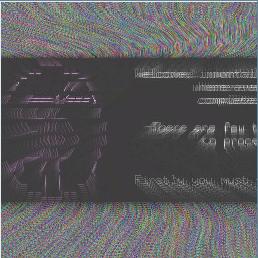|
Telnet supports (is supposed to support) colour.
The SciffyMUD is a glorified Telnet server.
It comes as no great shock, then, to realize that the SciffyMUD
allows
you, the game players and designers, to utilize colours. They can
be very useful at times - red for
danger, blue for
do not drink, and so on.
|
|
The SciffyMud supports ANSI colours directly, and these are
detailed below. However, it also defines a set of easy-to-use
macros. Typing in any one of these will set all following text
to the appropriate colour, or until the next macro overrides it:
Note: Using a lowercase letter for the foreground
(instead of a capital, e.g. &+r) makes the text non-bold
- &+R - foreground colour is red
- &+G - foreground colour is green
- &+Y - foreground colour is yellow
- &+B - foreground colour is blue
- &+M - foreground colour is magenta (or P for purple)
- &+C - foreground colour is cyan
- &+W - foreground colour is white
- &+L - foreground colour is black
- &-R - background colour is red
- &-G - background colour is green
- &-Y - background colour is yellow
- &-B - background colour is blue
- &-M - background colour is magenta (or P for purple)
- &-C - background colour is cyan
- &-W - background colour is white
- &-D - background colour is dark (i.e. black)
|
|
For those of you who prefer to do things the hard way, you can
always use ANSI-standard colours directly. For
completion, these are listed below:
These work in a
fairly simple way. You are probably most likely to understand this
by reading the examples at the end, but you can switch to a new
colour by typing in these elements in order:
- The Escape character (shown as ^[) says
"we're going to do something special"
- Optionally, the character 1, meaning "bold"
- or
- Optionally, the character 0, meaning "stop bold"
- Then a semicolon (if you used one of the last two)
- Then two characters for the colour of the text which you want:
- 30 - black
- 31 - red
- 32 - green
- 33 - yellow
- 34 - blue
- 35 - magenta
- 36 - cyan
- 37 - white
- Optionally, you can then specify the background colour, by using
a semicolon (;), and then one of the following pairs of
characters:
- 40 - black
- 41 - red
- 42 - green
- 43 - yellow
- 44 - blue
- 45 - magenta
- 46 - cyan
- 47 - white
- Finally the character of a small m means "we
have stopped doing the special weird thing". All text
after this will be shown in new colours (until the next
"tag")
|
|
Examples:
- Bold red text, black background
-
^[1;31;40m
- reverse-video (Plain black text, white background)
-
^[0;30;47m
- Bold purple (magenta) text, green background (garish!)
-
^[1;35;42m
- Special - Reset to normal colours
-
^[0m
|
|
If someone selects for "no colour", then the tags are deleted from
the escape character to the first m. If there is no m, then the
game could crash - so please be careful.
|
Other special things you can use are the ASCII control characters.
Some of these are:
- Character 7 - bell (make a lit'l beep noise)
- Character 8 - backspace (erases the last character)
- Character 13 - caridge return (go back to the start of the line)
- Character 27 - escape (used to set colours)
- Character 254 - used internally by the game, (as a
record-deliminator). Do not EVER use this character
yourself (it is the backward-paragraph-mark character,
by the way)!
|

